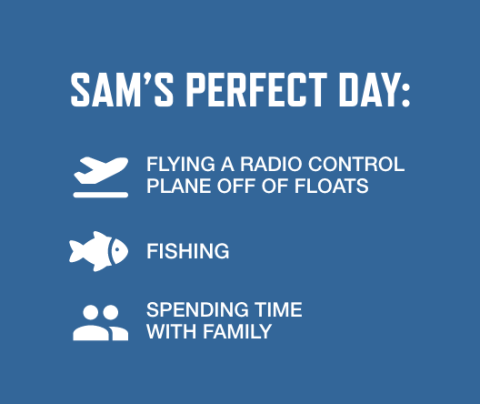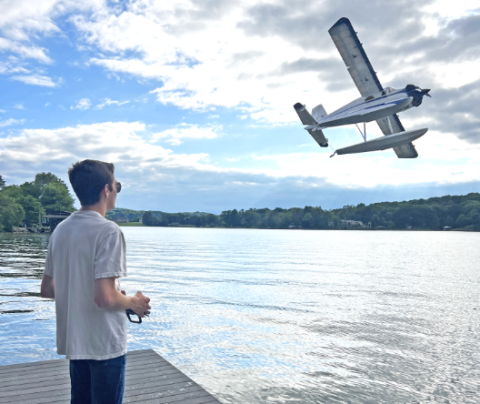
Mechanical engineer, unmanned aircraft enthusiast, builder
Sam Pankratz found his career passion through flying radio-controlled airplanes. It has taken him all over the country and led to countless friendships. Today, he works on unmanned aircraft for a living, at the intersection of lightweight materials, 3D printing (additive manufacturing), prototyping, and aircraft components.
Sam recently completed his Master of Science degree in Mechanical Engineering at the University of Tennessee (UT) and joined Anduril Industries, where he is working on the development of advanced unmanned aircraft systems for the U.S. military and its allies. He previously earned a bachelor’s degree in Aerospace Engineering from UT.
During his time in Knoxville, TN, Sam became part of the ecosystem at IACMI—The Composites Institute. IACMI is focused on advanced composite materials such as plastics, metals, building materials, and ceramics, which are used in products like wind turbines, aircraft, robots, and buildings. Sam was involved in several workforce training initiatives and worked closely with IACMI’s Chief Technology Officer, Uday Vaidya, on composites research.
As a UT graduate assistant at the university’s Fibers and Composites Manufacturing Facility (FCMF), Sam taught students about the multiple ways additive manufacturing is impacting the future of casting as part of IACMI’s new education and workforce initiative, METAL. Through his support of U.S. manufacturing, innovation, and education, Sam Pankratz embodies what it means to be a modern maker.
Q&A with Sam
How did you find your way to working in advanced manufacturing?
I have always been interested in building things since the time I first picked up a hammer in the garage at 5 years old. In middle school, I was working on radio control cars, and then in high school, it became airplanes and drones. I was always hands-on and curious about the mechanics of these things. In college, I worked on several unmanned aircraft projects and became involved in composites research. These things taught me about the real-world challenges of getting a vehicle in the air and the possibility of cutting-edge materials and processes to unlock new possibilities.


What does your job involve?
I work on end-to-end projects supporting unmanned aircraft. It means I get to have ownership over the whole process of parts and assemblies, from requirements and prototyping to validation and integration. I roll up my sleeves and perform that prototyping myself, which means collaborating with manufacturing engineers and technicians. Engineering doesn’t happen in a vacuum.
What is the most challenging part of your job?
Scaling manufacturing up is at least, if not more difficult, than designing a part in the first place. Designing for manufacturing must be considered throughout the entire process to ensure alignment between requirements and the manufacturing process of choice. On top of that, I have to consider cost and scale-up for manufacturing. It makes every step of the design process codependent on the manufacturing processes – something I’m always striving to learn more about.
What is the best part of your job?
Seeing my parts fly. There is nothing more compelling than seeing your own parts actually fly and perform to spec.
What advice do you have for someone new to the industry?
There has never been a better time to be in the aerospace industry. There are so many different opportunities in the industry right now, no matter your specific interest. Aerospace manufacturing specifically has huge demand as a critical point of emphasis to our economy and national security.
What makes you excited to go to work?
I get to work every day with top-level talent to design and deliver the best systems to our warfighters. These men and women deserve the best we have to offer as they defend our country, and I get to play a small part in equipping them for those jobs.
If you didn’t have to work, how would you spend your day?
I love solving all kinds of problems. I’d spend my days doing home improvement projects, working on my fish tank, or building a drone. These small, compartmentalized tasks will require that I research how it might be done, consider what I think I can do, how my needs are best solved, and then hopefully implement an elegant solution.

What activity gives you the most energy?
Making things! I always love the final machining operation to get my part out of the mill or demolding a composite part. There is magic in seeing a part come to life, and it never gets old.
Are there any hobbies that make you better at your career?
I’ve been flying radio-controlled airplanes for nearly 10 years. It has taken me all over the country. I’ve met countless friends through it, and I absolutely would not be here building aircraft had I never gotten into the hobby to find my passion.
How does the work you do impact the world?
Every day I work on developing the best possible technology for our men and women in uniform. While I may not be serving myself, I can still provide these brave people with the systems they need to protect us.




